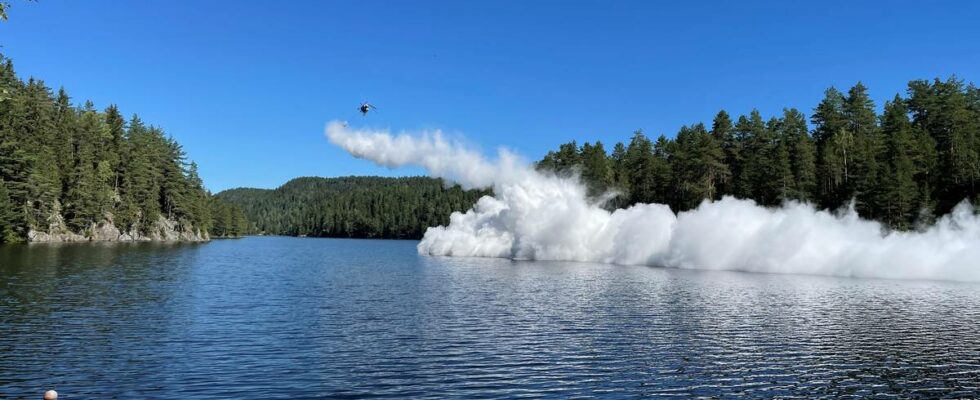The forest idyll southeast of Oslo is essentially protected against noise and disturbances. But recently a helicopter was allowed to make noisy low-flying flights over the newly established Østmarka National Park. Mosjøen in Enebakk received a total of eight tonnes of lime. Which is good for several of the species that live in the forest water. Photo: Dag Aasdalen / news Large buckets of grey-white lime powder were emptied into eleven of the forest waters. – If we hadn’t limed, then there are more species that would struggle, says Terje Wivestad at the State Administrator. Mussels and crayfish can die if the waters in Østmarka become too acidic, says Terje Wivestad, who is a senior adviser at the State Administrator in Østfold, Buskerud, Oslo and Akershus. Photo: Bård Nafstad / news He says there would be fewer aquatic insects and that the fish would have problems. – And species that are on the Norwegian red list of threatened and vulnerable species, such as crayfish and river mussels, will have trouble surviving, explains the senior advisor. Old environmental sins The forest waters both here and in many other places in Norway are still struggling with the after-effects of pollution from the last century. This is the powder that is emptied into the waters. The lime flour is basic, which is good when the water is acidic and therefore has a high pH value. Photo: Bård Nafstad / news Sulfuric pollution, which was called acid rain, came drifting with clouds from Great Britain and Eastern Europe. In the 1970s and 80s, acid rain was considered the biggest environmental threat Norway faced. CLARO CORTES IV / news What is acid rain? Acid rain contains sulfur dioxide and nitrogen, which are mainly caused by the burning of fossil fuels. The first reports that acidic water killed fish came as early as the 1920s. Six percent of Norway’s land area still receives more sulfur and nitrogen than nature can tolerate. Elena Elisseeva What has been done? In Norway, acidification has been particularly severe in Southern Norway and parts of Eastern Norway and Western Norway. In 1990, it was estimated that more than 9,000 fish stocks had been lost and over 5,000 stocks reduced due to acidification. Through international agreements, emissions to air have been greatly reduced in Europe. For sulphur, the reduction has been over 90 per cent since 1990. Source: Norwegian Environment Agency/SNL Paul Owesen Large protests against acid rain in Norway The damage Norwegian nature suffered due to acid rain from, among others, Great Britain caused outrage in Norway in the 1980s. Prime Minister Margaret Thatcher was met with large protests during a visit to Norway in 1986. The police used shields, tear gas, dogs and horses to control the demonstrators. At least 13,000 square kilometers of Norwegian lakes, corresponding to an area almost the size of Buskerud county, suffered extensive damage due to the acid rain. The fish disappeared from many Norwegian waters and extensive liming measures were initiated to reduce the acidity level and bring the fish back. Since that time, emissions have fallen sharply. But large sums are spent annually to repair damage caused by the acid rain. Nationally, more than NOK 75 million is spent on liming this year. The worst affected areas are in Southern Norway and South Western Norway. Flying in shuttle traffic – There will probably be 50 trips, says Jan Ivar Skjedsvold. He is a team leader in the helicopter company Pegasus, which flies out the lime flour in barrels and drops it over ponds and lakes. A total of 11 waters in Østmarka National Park were limed in the operation. Behind the levers Jarle Madtsen. Photo: Dag Aasdalen / news A barrel can contain up to one tonne. While Bærum-based Franzefoss Minerals is responsible for the liming in the national park. Although notices had been put up warning of the liming, the noisy activity probably came as a surprise to the hikers at the entrance to the national park. Lars Maanum, who was going to cycle through Østmarka to Vangen in Enebakk, stood and watched as the helicopter fetched new barrels of lime from the parking lot at Sandbakken. He thinks it is good that the damage from human pollution is being tried to be fixed. Kalkingen first causes a lot of noise in the national park. But there were no sour faces from this cyclist. Photo: Dag Aasdalen / news – We are the ones who have made this possible. Then we also have to allow it to be repaired and arranged so that the organisms, fish, birds and other animals that live in here get what they should have, he says. Hoping for a quick recovery The hope is that in the long run nature will manage without these giant buckets of lime. For Østmarka’s part, there are still a number of years until then, says Wivestad at the State Administrator. – We follow up with monitoring of water quality, and also trial fishing. So we assess it like that from year to year, but we expect that we will have to hold on for the next five years, he says. After liming, it can almost look like the morning mist is over the water. Photo: Bård Nafstad / news Published 19.08.2024, at 22.26
ttn-69
Water in Østmarka National Park struggles with old pollution, receives lime as medicine – Greater Oslo

